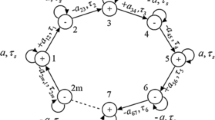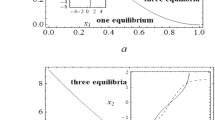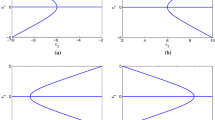Abstract
In this paper, we consider a delayed system of differential equations modeling two neurons: one is excitatory, the other is inhibitory. We study the stability and bifurcations of the trivial equilibrium. Using center manifold theory for delay differential equations, we develop the universal unfolding of the system when the trivial equilibrium point has a double zero eigenvalue. In particular, we show a universal unfolding may be obtained by perturbing any two of the parameters in the system. Our study shows that the dynamics on the center manifold are characterized by a planar system whose vector field has the property of 1:2 resonance, also frequently referred as the Bogdanov–Takens bifurcation with \(Z_2\) symmetry. We show that the unfolding of the singularity exhibits Hopf bifurcation, pitchfork bifurcation, homoclinic bifurcation, and fold bifurcation of limit cycles. The symmetry gives rise to a “figure-eight” homoclinic orbit.









Similar content being viewed by others
References
Arnold, V.I.: Loss of stability of self-oscillations close to resonance and versal deformation of equivariant vector fields. Funct. Anal. Appl. 11, 85–92 (1997)
Baldi, P., Atiya, A.: How delays affect neural dynamics and learning. IEEE Trans. Neural. Netw. 5(4), 612–621 (1994)
Bélair, J., Campbell, S.A.: Stability and bifurcations of equilibria in a multiple-delayed differential equation. SIAM J. Appl. Math. 54(5), 1402–1424 (1994)
Bogdanov, R.I.: Bifurcation of the limit cycle of a family of vector fields on the plane. Trudy Sem. Petrovskii 2, 23–36 (1976). (Russian)
Bogdanov, R.I.: Bifurcation of the limit cycle of a family of vector fields on the plane. Selecta Math. Soviet 1, 373–387 (1981). (English)
Bogdanov, R.I.: Versal deformation of a singularity of a vector field on the plane in case of zero eigenvalues. Trudy Sem. Petrovskii 2, 37–65 (1976). (Russian)
Bogdanov, R.I.: Versal deformation of a singularity of a vector field on the plane in case of zero eigenvalues. Selecta Math. Soviet. 1, 388–421 (1981). (English)
Campbell, S.A., Bélair, J.: Analytical and symbolically-assisted investigation of Hopf bifurcations in delay-differential equations. Can. Appl. Math. Q. 3(2), 137–154 (1995)
Bélair, J., Campbell, S.A., van den Driessche, P.: Frustration, stability, and delay-induced oscillations in a neural network model. SIAM J. Appl. Math 56, 245–255 (1996)
Campbell, S.A.: Stability and bifurcation of a simple neural network with multiple time delays. In: S. Ruan, G.S.K. Wolkowicz, J. Wu (eds.) Differential Equations with Applications to Biology, Fields Institute Communications 21, 65–79 (1999)
Campbell, S.A.: Calculating centre manifold for delay differential equations using Maple. In: Balachandran, B., Kalmár-Nagy, T., Gilsinn, D.E. (eds.) Delay Differential Equations: Recent Advances and New Directions. Springer, New York (2009)
Campbell, S.A., Yuan, Y.: Zero singularities of codimension two and three in delay differential equations. Nonlinearity 21, 2671–2691 (2008)
Chow, S.I.-N., Li, C., Wang, D.: Normal form and bifurcations of planar vector fields. Cambridge University Press, Cambridge (1994)
Faria, T.: Normal forms and bifurcations for delay differential equations. In: Arino, O., Kbid, M.L., Ait Dads, E. (eds.) Delay Differential Equations and Applications, p. V205. Nato Science SeriesSpringer, Berlin (2006)
Faria, T., Magalhães, L.: Normal forms for retarded functional differential equations with parameters and applications to Hopf bifurcation. J. Differ. Equ. 122, 181–200 (1995)
Gilsinn, D.E.: Bifurcations, center manifolds, and periodic solutions. In: Balachandran, B., Kalmár-Nagy, T., Gilsinn, D.E. (eds.) Delay Differential Equations: Recent Advances and New Directions. Springer, New York (2009)
Guckenheimer, J., Holmes, P.: Nonlinear Oscillations, Dynamical Systems, and Bifurcations of Vector Fields, Applied Mathematical Sciences 42. Springer, New York (1983)
Gopalsamy, K., Leung, I.: Delay induced periodicity in a neural netlet of excitation and inhibition. Physica. D 89(3–4), 395–426 (1996)
Hopfield, J.J.: Neurons with graded response have collective computational properties like those of two-state neurons. Proc. Natl. Acad. Sci. 81, 3088–3092 (1984)
Hale, J.K., Verduyn Lunel, S.M.: Introduction to Functional Differential Equations. Springer, New York (1993)
Qesmi, R., Ait, Babram M.: Symbolic computation for center manifolds and normal forms of Bogdanov bifurcation in retarded functional differential equations. Nonlinear Anal. 66, 2833–2851 (2007)
Kuznetsov, Y.A.: Elements of Applied Bifurcation Theory. Springer, Berlin (1998)
Kolmanovskii, V.B., Nosov, V.R.: Stability of Functional-Differential Equations, Mathematics in Science and Engineering, vol 180. Academic Press Inc, London (1986)
Marcus, C.M., Westervelt, R.M.: Stability of analog neural networks with delay. Phys. Rev. A 39, 347–359 (1989)
Olien, L., Bélair, J.: Bifurcations, stability, and monotonicity properties of a delayed neural network model. Physica D 102(3–4), 349–363 (1997)
Pakdaman, K., Malta, C.P., Grotta-Ragazzo, C., Arino, O., Vibert, J.-F.: Transient oscillations in continuous-time excitatory ring neural networks with delay. Phys. Rev. E 55, 3234–3248 (1997)
Perko, L.: Differential Equations and Dynamical Systems, 3rd edn. Springer, New York (2007)
Shayer, L.P., Campbell, S.A.: Stability, bifurcation and multistability in a system of two coupled neurons with multiple time delays. SIAM J. Appl. Math. 61, 673–700 (2000)
Stépán G.: Retarded Dynamical Systems: Stability and Characteristic Functions, Pitman Research Notes in Mathematics Series, 210. Longman Scientific & Technical, Harlow, copublished in the United States with Wiley, New York (1989)
Takens, F.: Forced oscillations and bifurcations. In Applications of Global Anslysis I, Communications of the Mathematical Institute Rijksuniversiteit Utrecht 3, (1974)
Ye, H., Michel, A., Wang, K.: Qualitative analysis of Cohen-Grossberg neural networks with multiple delays. Phys. Rev. E 51, 2611–2618 (1995)
Acknowledgments
Guihong Fan would like to thank Chunhua Shan for useful comments and discussion and the LAMPS Lab where the work was finished as a postdoctoral fellow.
Author information
Authors and Affiliations
Corresponding author
Additional information
The research of Campbell and Wolkowicz is partially supported by NSERC, Zhu is supported by NSERC and an Early Researcher Award, Ministry of Research & Innovation of Ontario, Canada.
Appendix
Appendix
1.1 Proof of Lemma 3.1
Proof
In order to study (3.18), we want to simplify it term by term. Before doing so, we show that the term \(\Psi (0)(L(\epsilon )-L(0)) h(z(t),\epsilon )\) only contributes to higher order terms of \(z\), which can be neglected. To use results of [21], we partially adopt its notation and rewrite
where \(h_k\) (\(2\leqslant k\leqslant m\)) is the homogeneous part of degree \(k\) and \(\chi (z,\epsilon )=o(|(z,\epsilon )|^m)\). If \(z=(z_1,z_2)\in \mathbb R ^2, q=(q_1,q_2), \epsilon =(\epsilon _1,\epsilon _2,\epsilon _3), \epsilon ^l=\epsilon _1^{l_1}\epsilon _2^{l_2}\epsilon _3^{l_3}\) for \(l=(l_1,l_2,l_3)\in \mathbb N ^3\), and \(|l|=\sum _{i=1}^3 l_i\), then we can rewrite \(h_k(z,\epsilon )\) as
where \(h_{(q,l)}^k\in \mathbb Q \) and \(D_k=\{(q,l)\in \mathbb N ^5:|(q,l)|=k\}\). Recall that \(\mathbb Q \) is the subspace of \(C=C([-h,0], \mathbb R ^n)\) defined in Sect. 3.1. Let \(R_{(q,l)}^{k-1}\in \mathbb R ^2\) with
being the homogeneous part of degree \(i\) of \(R(z,\epsilon )=(L(\epsilon )-L(0))(\Phi z+h(z,\epsilon )) +F(\Phi z+h(z,\epsilon ),\epsilon )\). In particular, for \(k=2, R^1\) is the homogeneous part of degree \(2\) of \((L(\epsilon )-L(0))(\Phi z)+F(\Phi z,\epsilon )\) which is independent from terms on the center manifold and given by
By Theorem 3.3**** of [21], for \(k=2\) and \((q,l)\in D_2\), we have
Since \(R^1(z,0)=0\), we have that \(h_{(q_1,0,0)}^2=0\). We can obtain that \(h_2(z,\epsilon )=O(|\epsilon |)O(|z|)\). We have
One can verify that for the linear terms of \(\dot{z}(t)\), we have
Let \(\mathcal L (z(t),\epsilon )=\begin{bmatrix} \mathcal L _1\\\mathcal L _2\end{bmatrix}= \Psi (0)(L(\epsilon )-L(0))\Phi (\theta )z(t)\). If we denote
then by using (2.6), we have
and
For higher order terms, we have
Letting \(\tilde{\mathcal{L }}(z(t),\epsilon )=\begin{bmatrix} \tilde{\mathcal{L }}_1\\\tilde{\mathcal{L }}_2\end{bmatrix}=\Psi (0)F(\Phi z(t))\), we have
and
Then the equation of \(z\) can be reduced to
or equivalently system (3.19) in an explicit form. \(\square \)
1.2 Proof of Lemma 3.2
Proof
By Lemma 3.1, we have obtained the explicit form of equations (3.19) on the center manifold. In order to get a universal unfolding of the perturbed system (3.9), we need to reduce the system further. To do that, let \(u=z_1\) and \(w=\dot{z}_1\).
Expanding \(w\) and substituting \(z_1=u\) gives
Assume that \(z_2=f_{10}u+f_{01}w+f_{30}u^3+f_{03}w^3+f_{21} u^2 w +f_{12}u w^2+O(|(u,w)|^4)\). Plugging in \(w\) and equating the coefficients of the same term yields
Then we have \(\dot{u}=\dot{z}_1=w\) and
Plug in \(\dot{z}_2\),
Noting that \(f_{10}=O(|\epsilon |)\) and \(f_{01}=1+O(|\epsilon |)\), we collect the similar order terms
Note that \(\dot{z}_2=O(|\epsilon |)u+O(|\epsilon |)w+O(|(u,w)|^3)\) and it only contributes \(\epsilon \) small terms to the third order terms of \(u\) and \(v\). We can neglect it. Plugging in the near-identity transformation
we have
Collecting the coefficients of common terms gives
with
and
Therefore
which is system (3.20). \(\square \)
1.3 Proof of Lemma 3.3
Proof
In order to simplify the third order terms in the equation of \(\omega \) in system (3.20), we use the method of Perko [27, p. 164–167] and take the near-identity transformation with undetermined coefficients \(x\) and \(\phi \) as
where
Then system (3.20) is reduced to
where
After simplification, we have
The near-identity transformation does not change the linear part of the system (3.3), but only has impact on the higher order terms. We want to select coefficients \(x\) and \(\phi \) so that the higher order terms of the \(y_1\) equation disappear i.e. \(\tilde{F}_{31}=0\) and the higher order terms of the \(y_2\) equation is as simple as possible. To be specific, we force the coefficients of \(y_1y_2^2\) and \(y_2^3\) in \(\tilde{F}_{32}\) and all coefficients of \(y_1^3, y_1^2y_2, y_1y_2^2\), and \(y_2^3\) in \(\tilde{F}_{31}\) to be zero. We have six equations and \(8\) undetermined coefficients \(x\) and \(\phi \) in total. There exists infinitely many solutions. For the sake of simplicity, we let \(x_{03}=0\) and \(\phi _{03}=0\) and obtain a set of coefficients given by:
Therefore
The system (5.1) is transformed to
Plugging in \(d_1, d_2, g_{30}\), and \(g_{21}\) gives system (3.21). \(\square \)
Rights and permissions
About this article
Cite this article
Fan, G., Campbell, S.A., Wolkowicz, G.S.K. et al. The Bifurcation Study of 1:2 Resonance in a Delayed System of Two Coupled Neurons. J Dyn Diff Equat 25, 193–216 (2013). https://doi.org/10.1007/s10884-012-9279-9
Received:
Revised:
Published:
Issue Date:
DOI: https://doi.org/10.1007/s10884-012-9279-9




